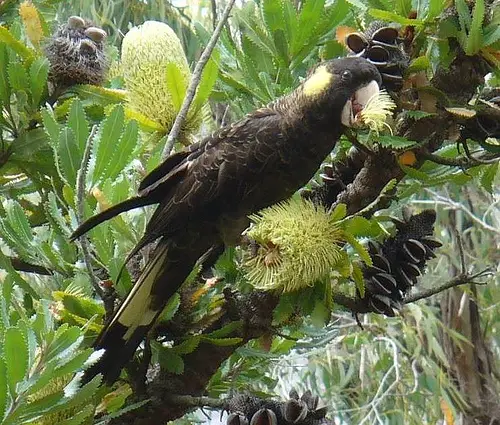

If a worm is detected, the parrot will use their powerful beak to pull items from the tree until you get to the meal, often leaving a pile of wood chips at the base of the tree. Seeds native trees, land plants, and pine cones. Some insects are also part of their diet. Unlike other cockatoos, a significant proportion of the wood borer diet worms. The bird put its ear against the surface of the dead trees to hear the warm sound. The chicks fledge about three months after hatching and remain with their parents until the next breeding season. Both parents help raise the baby, although only one baby survives.

The crest is small and not as impressive as other cockatoos. The female incubates the eggs while the male provides the food. The overall plumage is brownish black with white edges resulting in a scalloped pattern. They have a long breeding season, which varies throughout its range, although in Tasmania, in general, it is from October to February. Both sexes build the nest in holes in tall, mature trees, usually Eucalyptus. Fill the hole with wood chips. Tasmania is common and nomadic. They can be seen in many parts of the state and the larger Bass Strait Islands. Your number is declining in parts of its range due to habitat fragmentation and the loss of large trees used for breeding.

It belongs to the 2000-meter range throughout South East Australia, from the South Eyre Peninsula to East Central Queensland.

They are often seen flying in pairs or trios formed by a couple and their young, although outside the breeding season, they may join larger flocks. The yellow-tailed black cockatoo ( Zanda funerea) is a large cockatoo native to the south-east of Australia measuring 5565 cm (2226 in) in length. Variety of habitat types, including Eucalyptus forests, heathland, subalpine areas, pine plantations, and occasionally in urban areas.
Calyptorhynchus funereus xanthanotus ( Gould, 1838) – In Tasmania only, Smaller size, short dark spotted tail. Calyptorhynchus funereus whiteae ( Mathews, 1912) – Southern Australia (including Eyre Peninsula and Kangaroo Island ) and Western Victoria. Discolorations Feather discolorations, such as black tips on feathers, or the appearance of feathers that are not part of the normal coloration of your parrot species (such as a yellow feather on an eclectus where there should be a green or red feather) are problems that are almost always dietary in nature. Calyptorhynchus funereus funereus( Shaw, 1794) – Nominal. Eastern Victoria, New South Wales Yes Queensland, Larger and darker spotted tail. Location would help, but that's what it is. This is in addition to the annual submitting of all fauna records, every July.6 Yellow tailed black cockatoo pet Yellow-tailed black cockatoo subspecies Well, not an albino (albinos are very rare, they are all white with a red eye) but yes this is a leaucistic/lutino Yellow-tailed Black Cockatoo. The following species may be kept under a CLASS 1 BIRD KEEPER LICENCE OR COMPANION BIRD LICENCE.Īny transactions of COCKATOO species listed under CLASS 1 licence require written notification of from both parties within 10 days of all transaction. yellow-tailed black cockatoo (Calyptorhynchus funereus) and the red-tailed black cockatoo ( Calyptorhynchus banksii), a rare visitor to the Sunshine Coast. Both species are otherwise similar in appearance with white patches on. Red-Tailed Black Cockatoo Flying Animation Sequence Cartoon Vector Animal Animation EPS10 File Format black cockatoo stock illustrations. Baudins and Carnabys black cockatoos can be identified by their upper bill mandibles. Galah: Albino, dilute black-eyed white, red-eyed cinnamon, two distinct black-eyed cinnamon forms, silver, totally off white black eyed bird, a bird where the pink has been replaced by white and the grey remains. National Parks and Wildlife Service will issue your Companion Bird Licence for five years, and you must notify them about the source of the bird, which you require the licence for. Collection of different types of realistic cockatoo - red tailed black, salmon-crested, sulphur-crested, palm, long-billed corella, yellow-tailed black. Yellow-tailed Black Cockatoo: Yellow suffused variation. To maintain your Class 1 Licence you must maintain complete records of your birds, which must be submitted to the National Parks and Wildlife Service in July of each year. National Parks and Wildlife Service can issue your Class 1 Licence for either two or five years. You must contact National Parks and Wildlife Service to purchase a Class 1, or Companion Bird Licence before you purchase any of the species of native bird, classified under these licences. A Class 1 Bird Keeper Licence or Companion Bird Licence covers many common species of native bird that are usually obtained from licensed pet shops and require only a basic knowledge of bird care to be successfully raised and maintained in captivity.








 0 kommentar(er)
0 kommentar(er)
